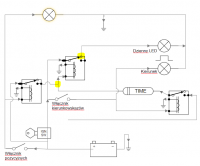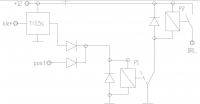Dear experts,
a topic recently very fashionable. LED bulbs appeared on the market, which shine in both colors - white and orange depending on which electrode voltage is applied. There are of course ready sets that do not know how they work, but I would like to connect such bulbs myself.
The idea is for the bulbs to glow white when the parking lights (dipped) are off (i.e. daytime running light function), but when I turn on the turn signal, the function should turn off during operation and turn on the Left or Right Turn Signal (K) function when work stops direction with a second delay or 2 seconds back should switch on daylight. With the parking and dipped headlights on, the directions should operate normally and the daytime running lights should be off. You probably saw such lights on the street in the latest Skoda Superb and other more expensive cars. Could it be easy to create such a scheme yourself? How would you approach this? Are there such relays with a switch-off delay? What would the connection diagram look like? I tried to draw it, but unfortunately I fell. Can you help?
a topic recently very fashionable. LED bulbs appeared on the market, which shine in both colors - white and orange depending on which electrode voltage is applied. There are of course ready sets that do not know how they work, but I would like to connect such bulbs myself.
The idea is for the bulbs to glow white when the parking lights (dipped) are off (i.e. daytime running light function), but when I turn on the turn signal, the function should turn off during operation and turn on the Left or Right Turn Signal (K) function when work stops direction with a second delay or 2 seconds back should switch on daylight. With the parking and dipped headlights on, the directions should operate normally and the daytime running lights should be off. You probably saw such lights on the street in the latest Skoda Superb and other more expensive cars. Could it be easy to create such a scheme yourself? How would you approach this? Are there such relays with a switch-off delay? What would the connection diagram look like? I tried to draw it, but unfortunately I fell. Can you help?





